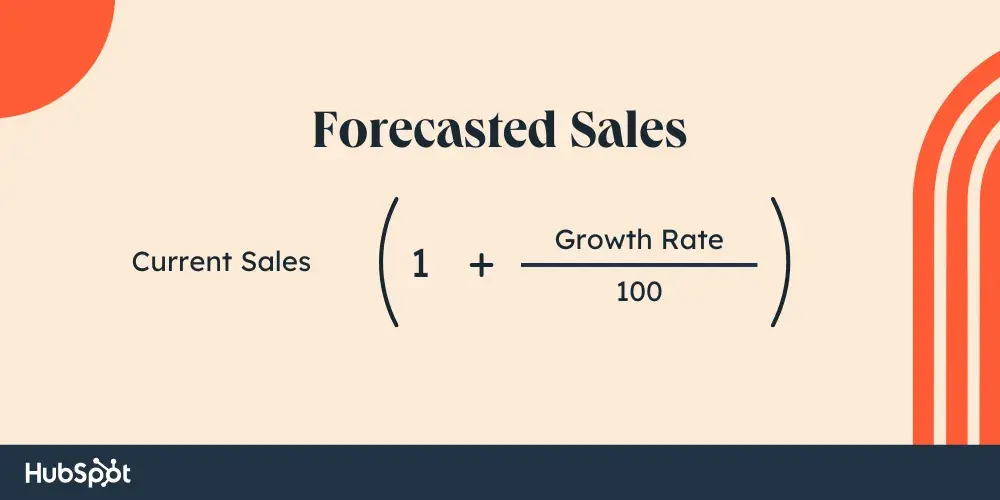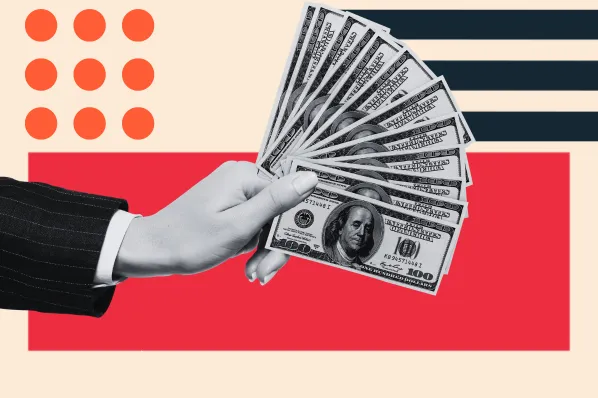A popular, efficient way to forecast sales is to employ something known as the percent of sales method. While some sales forecasts are so complicated and detailed that they make your head spin, this is a simple sales forecast that even the least numbers-oriented small business owners like me can use.
I’ll walk you through what this financial forecasting tool is, how to use it, and some of its benefits and shortcomings.
Table of Contents
- What Is the Percent of Sales Method?
- Steps of the Percent of Sales Method
- Benefits and Disadvantages of Percentage Forecasting
- Percentage of Sales Method Formula
- How to Calculate Percentage of Sales
What Is the Percent of Sales Method?
The percent of sales method is a financial forecasting model in which all of a business’s accounts — financial line items like costs of goods sold, inventory, and cash — are calculated as a percentage of sales. Those percentages are then applied to future sales estimates to project each line item’s future value.
The percent of sales method is one of the quickest ways to develop a financial forecast for your business — specifically for items closely correlated with sales. That’s its major advantage.
When to use: Use the percent of sales method when your business needs a very rough picture of its financial future immediately. This will help you quickly understand your financial outlook.
Benefits and Disadvantages of Percentage Forecasting
All sales forecasts have benefits and disadvantages attached to them. Here are some things I suggest you consider before relying on this model.
Benefits of Percentage Forecasting
Why bother using the percent of sales method? Here are a few benefits.
- Financial planning. The percent of sales method allows you to estimate what some balance sheet items will look like in future months, helping you develop accurate budgets.
- Quick to use. If you have historical sales data, you can generate estimated monthly sales revenue quickly and easily (we’ll do this together in a minute).
- Simplicity. Some sales forecasting models feel like they require an advanced degree to understand them. The percentage of sales method is simple and accessible for small businesses to leverage.
When used correctly, this can be a simple asset for assessing the success of your overall sales strategy.
Disadvantages of Percentage Forecasting
I should also mention the drawbacks to using the percentage of sales method. Here are a few disadvantages to consider.
- Limited scope. Bear in mind that this method only applies to line items that correlate with sales. Any fixed expenses — like fixed assets and debt — can’t be projected with the percent of sales method. All forecasted financial statements have limited accuracy.
- Doesn’t account for step costing. Step costing is when the cost of a product changes after a customer buys a quantity of that product over a discrete volume point. For instance, if a customer buys a product from a business that has a step cost at 5,000 units, then every unit beyond those first 5,000 comes at a discounted price.
- Not definitive. For a more conclusive financial analysis, you need a carefully detailed, line-by-line forecast.
Still, despite its shortcomings, I think the percent of sales method is a useful method worth understanding and being able to apply. Here’s the formula you should use.
Percentage of Sales Method Formula
The percent of sales method formula is current sales (1 + growth rate/100) = forecasted sales.
When used with accurate sales data, it can serve as a guide for your upcoming sales revenue. Let’s look at examples of this formula in action.

How to Calculate Percentage of Sales
I’ll walk you through the steps below, and then we’ll look at examples together of how this looks in action.
Step 1: Gather current data on estimated growth and annual revenue. Accurate forecasts can’t be calculated without accurate data, most importantly, your annual company revenue and estimated growth. Brand-new businesses, or businesses without historical data, will need to wait until they have enough data before calculating.
Let’s use the example of a potter named Harry, whose revenue was $100k last year, and he expects sales to increase 50% next year.
Step 2: Find financial line items that are related to sales — these are the accounts the percent of sales method applies to. Remember that fixed expenses are never included in this number. Those accounts often include:
- Inventory.
- Accounts receivable.
- Accounts payable.
- Cash.
- Costs of goods sold.
- Net income.
Our potter, Harry, looked at his monthly expenses and saw the following:
- Wages. He employs Ron, a fellow potter who earns a full-time wage regardless of how much they sell.
- Rent. The workshop is not free, and they pay the same number — no matter how much they sell.
- Clay. The raw materials used for pots.
- Firewood. The kiln needs to be heated.
Of these expenses, he sees that only the last two are tied to sales as they fluctuate.
Step 3: Determine balances and their percentages relative to sales. You’ll calculate this by dividing the above numbers by annual revenue.
Harry looked at his expenses and realized that for every $10 pot he sold, it cost him $2 in clay and $1 in firewood. Harry realizes that this comes down to the following percentages:
- Clay - 20%.
- Firewood - 10%.
Step 4: Calculate forecasted sales. Taking the data from step 1 (annual company revenue and expected growth), you’ll use the percent of sales method formula to calculate the forecasted sales: current sales (1 + growth rate/100) = forecasted sales.
Harry expects to increase his revenue by 50%, which leads him to come up with the following equation:
- 100k (1 + 50/100) = 150,000
Step 5: Apply line items’ relative percentages to your forecasted sales figure. This approach ensures that your budget for expenses scales in proportion with anticipated revenue.
To come up with a budget for next year that accounts for the increase in sales, Harry now knows that from that $150k:
- 20% goes to clay.
- 10% goes to firewood.
In his financial plan, Harry knows to budget:
- $30k (20% of 150k) for clay.
- $15k (10% of 150k) for firewood.
These are high-level overviews of how this formula is calculated. I’ll now zoom in on one detailed case study and go through this whole process in detail.
Steps of the Percent of Sales Method
- Determine your estimated growth and most recent annual sales figures.
- Determine if a correlation between sales and specific line items you want to forecast exists.
- Determine the line item balances and their percentages relative to sales.
- Calculate forecasted sales.
- Apply line items' relative percentages to your forecasted sales figure.
For the sake of example, let’s imagine a hypothetical businessperson, Barbara Bunsen. She operates a specialty cake, army bed, and cinnamon roll shop called “Bunsen’s Bundt, Bunk Bed, Bun Bunker” or “B6” for short. We’ll use her business as a reference point for applying the percent of sales method.
1. Determine your estimated growth and most recent annual sales figures.
When Barbara started her shop, her friends and family told her to pump the brakes a little. They said, “Barbara, maybe reign it in a bit? People don’t want to buy bundt cakes at a shop that also sells military surplus bunk beds.” Little did they know that the pastry-loving veteran niche is incredibly lucrative. And she was able to do $50,000 in sales her first year and anticipates sales will increase 40% in the coming year.
She decides she wants to put together a rough financial forecast for the future, so she opts to leverage the percent of sales method. Now that she has the relevant initial figures, she can move on to the next step.
2. Determine if a correlation between sales and specific line items you want to forecast exists.
Before she can put her forecast together, Barbara has to see which financial line items are correlated with her sales figures. She will look closely at:
- Inventory.
- Accounts receivable.
- Accounts payable.
- Cash.
- Costs of goods sold.
- Net income.
Once she has the specific accounts she wants to keep tabs on, she has to find how they stack up to her overall sales figures.
3. Determine the line item balances and their percentages relative to sales.
Let’s say Barbara’s accounts have these balances:
- Inventory - $20,000.
- Accounts receivable - $10,000.
- Accounts payable - $7,000.
- Cash - $15,000.
- Costs of goods sold - $15,000.
- Net income - $35,000.
When divided by Barbara’s $50,000 in revenue, those figures amount to these percentages:
- Inventory - 40%.
- Accounts receivable - 20%.
- Accounts payable - 14%.
- Cash - 30%.
- Costs of goods sold - 30%.
- Net Income - 70%.
Next, Barbara needs to calculate her estimated sales for the upcoming year.
4. Calculate forecasted sales.
As previously mentioned, she expects to see a 40% increase. To determine her forecasted sales, she would use the following equation:
current sales (1 + growth rate/100) = forecasted sales
Barbara Bunsen’s Bundt, Bunk Bed, Bun Bunker is expected to see a 40% increase in total sales next year. So, calculating her forecasted sales would look like this:
50,000 (1 + 40/100) = 50,000 (1.4) = $70,000
From there, she would determine the forecasted value of the previously referenced accounts.
5. Apply line items’ relative percentages to your forecasted sales figure.
Barbara’s figures would look like this:
- Forecasted inventory - $28,000.
- Forecasted accounts receivable - $14,000.
- Forecasted accounts payable - $9,800.
- Forecasted cash - $21,000.
- Forecasted costs of goods sold - $21,000.
- Forecasted net income - $49,000.
Final Thoughts
Ultimately, I think the percent of sales method is a convenient but flawed process of financial forecasting. It’s useful in that it can provide a solid picture of what certain balance sheet items will look like going forward, and should only be applied to specific line items that you can prove have a correlation with your sales figures.
By no means is it meant to be hailed as a definitive document of every aspect of your company’s financial future. If you want a clearer, more accurate picture of where your company is headed financially, I’d say you’re better off with a carefully detailed, line-by-line forecast that considers other aspects beyond your sales level.
I recommend using this method in conjunction with other popular forecasting tools, like a credit sales method, sales conversion, and close rate, for a clear understanding of your company’s financial future.
I find that it helps to move beyond a basic spreadsheet when tackling sales calculations. Try the HubSpot sales calculator today to make this process much more approachable and accurate.
Sales Forecasting
.png?width=112&height=112&name=Sales%20Conversion%20and%20Close%20Rate%20Calculator%2001-300%20(1).png)

.png)
![How to Choose the Right Forecasting Technique [+ Expert Insight and Data]](https://53.fs1.hubspotusercontent-na1.net/hubfs/53/forecasting-methods-1-20241205-4072635.webp)
-Feb-24-2025-07-49-23-4986-PM.png)






![I Took a Deep Dive Into Trend Forecasting: Here’s What I Learned [+ Expert Tips]](https://53.fs1.hubspotusercontent-na1.net/hubfs/53/trend-forecasting-1-20241114-1048511.webp)
